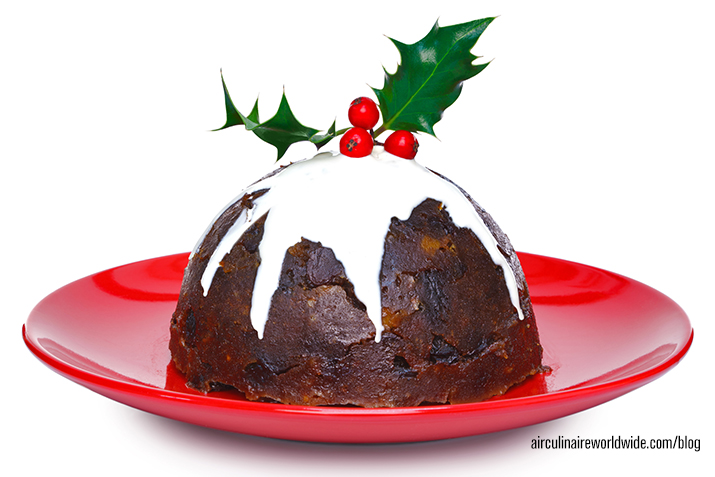Once the main course has been enjoyed, followed by a suitable break to aid digestion (which usually includes traditional parlour games, such as charades), it is time to move onto the dessert, which must of course be the English Christmas Pudding, Plum Pudding or Figgy Pudding – as the song goes!
The pudding originated in the 14th Century and was quite different to the pudding we serve today. Originally, it consisted of beef, mutton, prunes, raisins, currents and spices, and was runny in consistency – almost porridge-like.
In the 15th Century, we began to add eggs, breadcrumbs and more dried fruit to thicken the texture. Beer and spices were added for flavour. In 1664, the pudding was banned by the puritans, but it was reinstated in 1714 by King George I.
The Sunday before Lent, which is five weeks before Christmas Day, is when the pudding was traditionally made and has become known as “Stir Up Sunday.” Every member of the family is involved in stirring the pudding; each of them making a silent wish for the New Year ahead.
Another tradition is to place a silver sixpence (or, more recently, silver charms) inside the Christmas Pudding to bring luck to whoever may be the recipient in their desert. Charms are a little different and may include a silver thimble which, if found by a single lady, it is believed she will remain single for the forthcoming year. The gentleman’s version of this would be a Batchelor’s Button. Make sure the money or charms are well-wrapped in grease-proof paper if you choose to add these to your pudding.
The pudding would be wrapped in muslin and steamed, which is still the best method of cooking for Christmas Pudding to this day. This process helps it to retain moisture and allows all the flavours to infuse.
We often now choose to pour a little brandy over the pudding and set it alight when serving. This adds a little theatre to your Christmas Day celebrations, but take when lighting it.
Finally, serve your pudding with a rich rum sauce. Recipes for the Christmas pudding, rum sauce and a special festive beverage are detailed below.
Christmas Pudding
- 1 lb. seedless raisins
- 5 oz. currants
- 5 oz. chopped mixed peel
- 5 oz. naturally-coloured glace cherries
- 2 oz. chopped blanched almonds
- 6 oz. fine bread crumbs
- 6 oz. chopped suet (beef or vegetable)
- 4 large eggs lightly beaten
- 4 fl. Oz. brown ale or stout
- 3 tablespoons brandy or rum
- Butter to grease the pudding basin
Method
- Brush the inside of a pudding basin which is 17cm (7”) in diameter with softened butter.
- Place all dry ingredients into a large mixing bowl. In another bowl, combine the lightly-beaten eggs with ale and brandy or rum. Pour the egg and ale mixture into dry ingredients mix, and stir well until thoroughly combined.
- Spoon into the prepared basin and cover the surface of the mixture with a circle of grease-proof paper. Cover the top of the pudding basin with a piece of tin foil which is slightly larger than the top – shiny side down – and smooth the overlap down the sides of the bowl to seal it.
- Make a tin foil sling by taking a piece of tin foil roughly 60 cm (23”) long, fold it lengthways several times until it is roughly 10cm (4”) in width. Make it into a sling around the base of the pudding bowl, so it can be lowered into a pan.
- Take a pan which is large enough to easily hold the pudding basin, lower the basin into the pan and add enough water to the pan to come halfway up the sides. Cover the pan with a lid and simmer for over a very moderate heat for roughly 7 hours ; making sure you top up the water, when needed.
- Remove from heat and allow to cool for a few minutes. Use the tin foil sling to lift the basin from the pan. Allow the pudding to cool and store in a cool place until the pudding is required.
- For service on Christmas Day, place the pudding basin back into the pan again using the foil sling and steam for a further 2 hours. Turn the pudding out onto a large plate pour a little brandy or rum over the pudding and light. Serve with the Rum Sauce recipe below.
Rum Sauce
- 4 oz. butter
- 2 oz. plain flour
- 2 pints milk
- 3 oz. demerara sugar
- 4 fl. oz. rum
- 5 fl. oz. whipping cream
Method
- Melt butter slowly in a heavy-based saucepan. Add flour and stir in slowly. Place over low heat until pale and bubbling.
- Gradually add milk; stirring continuously until thickened. Add sugar and continue to stir over a low heat for a further 5 minutes.
- Remove from the stove and add rum and whipping cream.
Of course, Christmas Day would not be complete without a glass of Mulled Wine. Serve to your guests as they arrive to warm them through until dinner is ready.
Mulled Wine
- 1 bottle red wine
- 1 sliced orange
- 1 sliced lemon
- 2 cinnamon sticks
- 6 cloves
- 200 g castor sugar
Method
- Place all ingredients into a pan and heat gently. Take care not to let it boil.
- Pass through a fine sieve before serving.
The wine should be served warm but not too hot. You can use an insulated flask to serve the wine from and keep it warm.
Don’t forget to wear your Christmas jumper! National Christmas Jumper Day in England this year is going to be Friday the 16th of December! People from all over the country wear their Christmas jumper and donate money to charity. Many schools and businesses get involved which makes it a great way to raise money while having fun.
Enjoy!
Questions?
If you have any questions about this article, contact Vivienne Yeoman at vivienneyeoman@talktalk.net.
| This is an article by guest author Vivienne Yeoman, a catering industry expert based in London, England. Vivienne has over 30 years of experience in the catering industry as an Operational Manager. Any thoughts expressed in this article are entirely Vivienne’s and do not necessarily reflect the views of Air Culinaire Worldwide. |
If you would like to be considered for becoming a guest author, please contact socialmedia@airculinaire.com.






